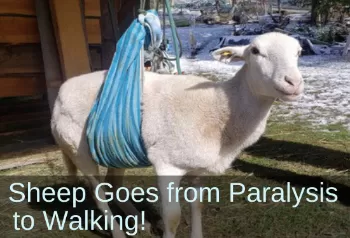Primitive Reflex Integration Case Studies
Rhythmic Movements Save Injured Sheep
Innate movements restore sensory motor connection and walking
This sheep's legs had lost the ability to coordinate and bear weight, leaving her functionally paralyzed. Her owner began applying rhythmic movements, and in just 4 days the sheep started taking steps again. 6 months later the ewe was pregnant and able to walk without falling.
Submitted by Catherine Kammann, OTR

| Before | After |
|---|---|
| Had lost motor connection with limbs due to lying down too long while stuck in a fence; essentially paralyzed | Able to get up on her own and walk |
My sheep Daisy got “cast” by getting stuck in a fence. A cast sheep is a sheep that lays down for too long and then actually loses sensory motor connection with their limbs and essentially becomes paralyzed. I thought she was a goner for sure as she was unable to bear weight on her legs at all. She just collapsed every time we managed to prop her up. I decided it was worth giving some of the movements I learned in the Brain and Sensory Foundations course a try.
Using an old towel, rope, and a pulley, I rigged up a sling to hold her up. I started with minimal weight on her hooves as I did not want to stress joints. I provided a lot of touch stimulation via massage to legs and lots of passive range of motion to all leg joints to get circulation going. Then I started doing a modified Rhythmic Movement #1 [from the Brain and Sensory Foundations course]. Rocking her forward/back along the axis of her spine.
On the second day I felt slight activation on Daisy’s part, as she tried to actively do some of these movements. I felt motivated to continue. Daisy became more and more active as she tried to walk. She was not able to engage in alternating movements and instead would assume a full extension pattern in a big explosive burst, launching out of the sling on two occasions.
I continued with my rhythmic movements and her extension burst became more refined. I then added side-to-side [rhythmic] movements as well in order to develop laterality. When standing I picked up her feet to mimic walking. By Day 3, Daisy started to take a couple of steps with her front legs, her hind-quarter still did not seem “connected”. We continued with rhythmic movements [from the Brain and Sensory Foundations course] and I got another person to help mimic foot movements as required by gait. Daisy started to use her hind legs by the end of the day.
Initially she would try to use the front and back leg on the same side of her body simultaneously, again working only ipsilaterally. While in the sling we motivated her with treats to move from side to side. By the end of the day she had figured out how to take ~5 steps.
We progressively decreased the amount of support offered by the sling. By Day 4, Daisy only spent the morning in the sling and by mid morning she was tottering along with her flock. She fell a lot and she was initially not able to get up on her own as she continued having difficulty coordinating the front and back of her body. We basically had to assume an STNR [Symmetrical Tonic Neck Reflex] position with flexion in the front and extension in the back, which we practiced until Daisy was able to get up on her own.
Thanks Sonia, for helping me help my sheep. Six months later and she is a happy lady expecting lamb(s) within the next couple of weeks. She is still just a little less coordinated than her peers but I think that makes her more charming.
[Edited for length and clarity, emphasis added]
*Disclaimer: The activities in the Brain and Sensory Foundations curriculum make use of the natural processes of neuroplasticity and development that are innately wired in the design of human beings to promote maturity and function. These activities appear to calm, organize, and mature the neuro-sensory-motor systems just as we see in the healthy development of human infants. Individual results may vary, and we do not claim to offer a diagnosis or cure for any specific condition or disorder. The Brain and Sensory Foundations activities appear to improve overall functioning resulting in measurable improvements for a range of conditions as demonstrated in over 1800 case studies from participants.

